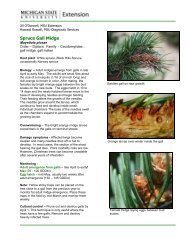Integrated Pest Management for Christmas Tree Production: A ...
Integrated Pest Management for Christmas Tree Production: A ...
Integrated Pest Management for Christmas Tree Production: A ...
You also want an ePaper? Increase the reach of your titles
YUMPU automatically turns print PDFs into web optimized ePapers that Google loves.
Disadvantages:<br />
1. Oils must come in contact with the<br />
targeted pest to be effective.<br />
2. Field conditions and weather during<br />
applications may limit effi cacy.<br />
3. Eggs will only be controlled if they are<br />
present be<strong>for</strong>e the oil application.<br />
4. Oil has no residual effect.<br />
Cautions:<br />
1. When temperatures are below freezing,<br />
oil can cause phototoxicity. Under<br />
these conditions, the oil and water cannot<br />
stay mixed and the water freezes,<br />
allowing oil droplets to accumulate.<br />
When thawing does occur, the water<br />
will evaporate, concentrating the oil on<br />
plant surfaces.<br />
2. Oil can also cause phototoxicity when<br />
temperatures are above 90°F. Burning is<br />
also a concern on the sunny side of the<br />
trees or during times of drought.<br />
3. Apply oils when conditions allow <strong>for</strong><br />
prompt drying; be sure to avoid drift or<br />
overspray.<br />
4. Mistaken dormancy is a problem in<br />
early fall or late spring. In early fall, if<br />
the plant is not in dormancy and the<br />
leaves are water defi cient, then the oil<br />
will burn the foliage. In late spring, new<br />
growth is burned if the dormant period<br />
ends be<strong>for</strong>e the oil is applied.<br />
5. Conifers known to be sensitive to<br />
dormant oils include Douglas-fi r and<br />
spruce. Be sure not to spray oil on<br />
glaucous, or blue, varieties of conifers<br />
because the blue color will be removed<br />
and may not return <strong>for</strong> 2–3 years.<br />
Genetic variability may affect individual<br />
plants differently, even if the variety<br />
is known to be tolerant to oil.<br />
When using oil, as with any pesticide,<br />
be sure to follow label directions. Some<br />
oils can be mixed with other pesticides to<br />
increase the level of toxicity. Never mix<br />
oils with dimethoate or any type of sulfur,<br />
as serious phytotoxic reactions will result.<br />
Most fungicides are not compatible with<br />
oils. Always consult the oil and insecticide<br />
labels <strong>for</strong> compatibility. Always choose<br />
“superior-type” oils to provide further<br />
insurance that these products are safe.<br />
TRADITIONAL<br />
This largest group of pesticides includes<br />
insecticides, miticides, fungicides, and<br />
herbicides. They can be the most effective<br />
materials available to prevent and destroy<br />
pests; however, they are frequently used<br />
when other options are available. For many<br />
years, broad-spectrum insecticides were the<br />
only tools available to growers. In recent<br />
years, newer, soft materials targeting specifi c<br />
groups of pests have been introduced. These<br />
materials are less likely to disrupt natural<br />
enemies while keeping the target pest in<br />
check.<br />
The use of traditional pesticides should<br />
always be a last resort. If a traditional<br />
pesticide application is a must, choose the<br />
right product, time, and dosage to avoid<br />
problems. Inappropriate use may rid the<br />
area of pests now, but it may also cause a<br />
more serious problem later as pests become<br />
resistant and natural enemies are depleted.<br />
For maximum benefi t and to avoid hazards,<br />
choose <strong>for</strong>mulations that pose the least<br />
threat to nontarget species. Be sure to rotate<br />
classes of pesticides to decrease the chances<br />
of pests developing resistance. Always read<br />
the label be<strong>for</strong>e using any pesticide product.<br />
IPM BASICS ............................................................................................................................................................................................................................................................................................ 15





